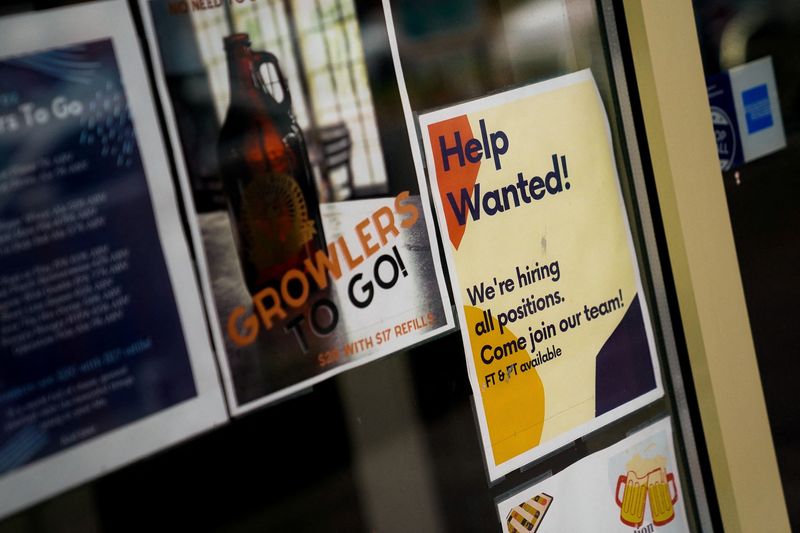Select Language

By Lucia Mutikani
WASHINGTON (Reuters) - U.S. job growth likely slowed further in July, but retained enough momentum to shield the economy from a recession as hefty interest rate increases from the Federal Reserve cooled demand.
The Labor Department's closely watched employment report on Friday is still expected to show a tight labor market, with the unemployment rate steady near multi-decade lows, though wage growth probably moderated. It would follow on the heels of data last month showing consumer spending resilient and the increase in annual inflation slowing sharply in June.
Economists who have long been forecasting a downturn by the fourth quarter of this year are increasingly becoming convinced that the "soft-landing" scenario for the economy envisaged by the Fed is now possible.
"There are signs that labor demand is decelerating, but it's not like it's fallen off a cliff," said Sam Bullard, a senior economist at Wells Fargo (NYSE:WFC) in Charlotte, North Carolina.
"Certainly, if we get another payrolls number in the 200,000 region, that would add to evidence that the Fed can engineer a soft landing."
Nonfarm payrolls likely increased by 200,000 jobs last month, after rising 209,000 in June, according to a Reuters survey of 80 economists. That would be the smallest gain since December 2020. Still, employment growth would be double the roughly 100,000 jobs per month needed to keep up with the increase in the working age population.
Companies are hoarding workers after struggling to find labor during the COVID-19 pandemic. Employment in some areas like leisure and hospitality remains below pre-pandemic levels.
Local government education also experienced accelerated retirements, which is boosting the hiring of teachers and support personnel. Economists did not see an impact from a heat wave, which blanketed large swathes of the country in July.
"While the extreme heat may have delayed some construction projects and postponed certain leisure activities, history suggests that heat waves have little impact on hiring or work hours," said Carl Riccadonna, chief economist at BNP Paribas (OTC:BNPQY) in New York. "Rather, inclement weather disruptions tend to occur during the winter and around the hurricane season."
Striking Hollywood writers and actors also likely had no impact on employment growth. The Labor Department's Bureau of Labor Statistics, which compiles the employment report, made no mention of the work stoppage in its July strike report.
MIXED SIGNALS
July's payrolls could surprise in either direction. The ADP's national employment report on Wednesday, pointed to strong private hiring last month. First-time applications for state unemployment benefits were much lower in July relative to June.
U.S.-based employers announced the fewest layoffs in 11 months in July, according to global outplacement firm Challenger, Gray & Christmas. But the Institute for Supply Management's measures for the manufacturing and services industries employment softened, with companies citing slowing demand and worker shortages.
The Labor Department reported on Tuesday that there were 1.6 job openings for every unemployed person in June, little changed from May. The abundance of unfilled jobs, together with the Conference Board's consumer confidence survey in July showing households bullish on the labor market, poses a risk to the unemployment rate.
The jobless rate is forecast unchanged at 3.6% last month, staying within striking distance of levels last seen more than 50 years ago. It is well below the Fed's latest median estimate of 4.1% by the fourth quarter of this year.
With the labor market still tight, wages likely continued to rise though at a moderate pace. Average hourly earnings are forecast climbing 0.3% after increasing 0.4% in June.
That would lower the year-on-year increase in wages to 4.2% from 4.4% in June. Though annual wage growth remains too high to be consistent with the Fed's 2% inflation target, it would be the latest indication of wage pressures continuing to subside into the third quarter. Growth in wages and unit labor costs moderated in the second quarter.
The raft of inflation-friendly data has led many economists to believe that the Fed's fastest rate hiking cycle in more than 40 years was probably over. The U.S. central bank has raised its policy rate by 525 basis points since March, 2022.
"We are not there yet, but we are approaching a Goldilocks economy," said Sung Won Sohn, Finance and Economics professor at Loyola Marymount University in Los Angeles.
But some economists argued that the Fed was not done raising rates, citing its laser focus on inflation.
"The hawks at the Fed may become increasingly uncomfortable with the possibility of reemerging inflation if the labor market remains so tight," said Veronica Clark, an economist at Citigroup (NYSE:C) in New York. "We expect a few somewhat stronger inflation readings into the fall and a labor market that remains stronger than the Fed's latest forecasts will likely lead to Fed officials raising rates again in November."

